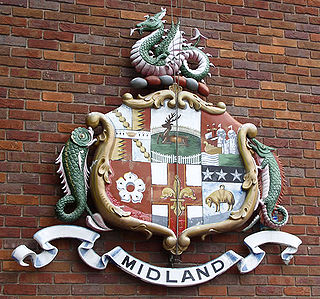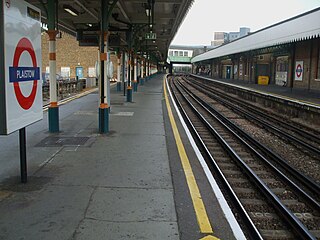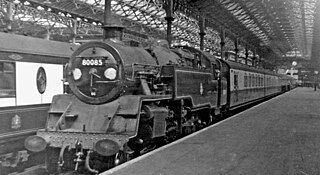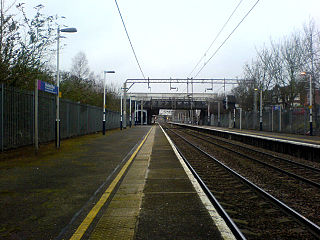
The Locomotives of the Midland Railway, followed its small engine policy. The policy was later adopted by the London, Midland and Scottish Railway, and contrasted with the London and North Western Railway's policy. The small engine policy was partly the consequence of a difference in the background of senior managers. In most railway companies, the elite position was the design, construction and maintenance of locomotives. Bigger engines brought more prestige and allowed longer trains. In the Midland, the marketing department was paramount. They recognised that people wanted more frequent, shorter trains rather than an infrequent service. It concentrated on very light, very fast and frequent trains.

Plaistow is a London Underground station on Plaistow Road in the London Borough of Newham in Greater London. It is between West Ham and Upton Park stations on the District and Hammersmith & City lines, and in Travelcard Zone 3.

Becontree is a London Underground station on Gale Street in the Becontree neighbourhood of the London Borough of Barking and Dagenham in northeast London, England. The station is on the District line, between Upney and Dagenham Heathway stations and is in Travelcard Zone 5. The station was originally opened as Gale Street Halt in 1926 by the London, Midland and Scottish Railway on the existing route from Fenchurch Street to Southend. The station was renamed and completely rebuilt in 1932 with an additional pair of platforms to serve the electric District Railway local service. National rail services ceased to call at the station since the 1960s, leaving only two platforms in operation.

Under the Whyte notation for the classification of steam locomotives by wheel arrangement, 4-4-2 represents a configuration of four leading wheels on two axles, usually in a leading bogie with a single pivot point, four powered and coupled driving wheels on two axles, and two trailing wheels on one axle, usually in a trailing truck which supports part of the weight of the boiler and firebox and gives the class its main improvement over the 4-4-0 configuration.

The British Railways Standard Class 4 tank is a class of steam locomotive, one of the BR standard classes built during the 1950s. They were used primarily on commuter and outer suburban services.

The Romford–Upminster line is a railway branch line in Greater London that connects Romford, on the Great Eastern Main Line, to Upminster, on the London, Tilbury and Southend Line and London Underground. The route is 3 miles 30 chains (5.4 km) in length and there is one intermediate station at Emerson Park. The line is part of Network Rail Strategic Route 7, SRS 07.09, and is classified as a rural line.
A number of different numbering and classification schemes were used for the locomotives owned by the London, Midland and Scottish Railway (LMS) and its constituent companies; this page explains the principal systems that were used.

LMS Stanier Class 4P 3-Cylinder 2-6-4T is a class of steam locomotive designed for work over the London, Tilbury and Southend Railway route. All 37 were built in 1934 at Derby Works and were numbered 2500–2536. The third cylinder was provided to allow increased acceleration between the many stops on the L.T.&S.R. line. From 1935 the LMS switched to constructing a very similar, simpler, 2-cylinder design. In 1941 two of the class had just been released from overhaul from Derby Works at the same time as a Jubilee class 4-6-0 failed in Derby station. The two tanks took over and got the train into St Pancras only 25 minutes late.

The London, Tilbury and Southend Railway (LTSR) 79 Class is a class of 4-4-2T suburban tank engines. They were designed by Thomas Whitelegg, as a development of the earlier 37 Class.
The London, Tilbury and Southend Railway 51 class was a class of 4-4-2T steam locomotives. Twelve were built by Sharp, Stewart and Company to the design of Thomas Whitelegg for the London, Tilbury and Southend Railway in 1900, with North British Locomotive Company supplying an additional six in 1903. The LTSR numbered them 51–68, and named them places in London and Essex.
Locomotives of the London, Tilbury and Southend Railway. Initially, the London, Tilbury and Southend Railway (LTSR) hired Eastern Counties Railway]] (ECR) locomotives and then after the amalgamation of that railway into the Great Eastern Railway (GER), locomotives from that company were hired. In 1880 the company bought its first locomotive saving on hiring costs from the GER and further engines followed that year. The LTSR principally operated tank engines, which it named after towns on the route. The railway's first locomotive superintendent was Thomas Whitelegg, who in 1910 was succeeded by his son Robert. The LTSR became part of the Midland Railway (MR) in 1912, but nevertheless continued to be operated independently. The Midland removed locomotive names and renumbered engines. The Midland, and its successor the London, Midland and Scottish Railway (LMS), continued to build some designs.

The LT&SR 69 class was a class of 0-6-2T steam locomotives designed for freight work on the London, Tilbury and Southend Railway. Six were initially built in 1903 to the design of Thomas Whitelegg, four more followed in 1908, and a further four in 1912, after the LT&SR's takeover by the Midland Railway (MR) in that year, giving a total of 14. The Midland renumbered them 2180–2193, and all entered LMS stock upon the grouping of 1923. The LMS renumbered them 2220–2233 in 1923, but then took them back to 2180–2193 in 1939. In 1947 they were again renumbered 1980–1993 by the LMS, and in 1948 all were acquired by British Railways. BR added 40000 to their numbers so they became 41980–41993. Withdrawals started in 1958, and by 1959 all but 41981 had gone. The last engine was withdrawn in 1962, and none of the small fleet were preserved.
The LT&SR 49 class was a class of 0-6-0 steam locomotives. They were the only tender engines used by the London, Tilbury and Southend Railway. They were originally ordered by the Ottoman Railway in Turkey, however that order was cancelled after they had been built and instead they were sold to the LT&SR in 1898. The LT&SR numbered them 49 and 50.
The LTSR 37 class was a class of 4-4-2T suburban tank engines built for the London, Tilbury and Southend Railway in 1897–98. They were designed by Thomas Whitelegg as a development of the earlier LT&SR 1 Class.
The London, Tilbury and Southend Railway 1 class was a class of 4-4-2T suburban tank engines. Thirty-six were built between 1880–1892, by Sharp, Stewart and Company and Nasmyth, Wilson and Company. They were the first locomotives owned by the LTSR, as previously all train services had been run by the Great Eastern Railway (GER) under contract.

Southend East railway station is on the London, Tilbury and Southend Railway line, serving the Southchurch area to the east of Southend-on-Sea, Essex. It is 36 miles 49 chains (58.9 km) down the main line from London Fenchurch Street via Basildon and it is situated between Southend Central to the west and Thorpe Bay to the east. Its three-letter station code is SOE.
The Glasgow and South Western Railway 540 Class were 4-6-4T steam tank locomotives designed by Robert Whitelegg and built in 1922, shortly before the G&SWR was absorbed into the London Midland and Scottish Railway (LMS). They were referred to in official G&SWR publicity as the Baltic Class, although they were also known more prosaically to enginemen as the 'Big Pugs'.













